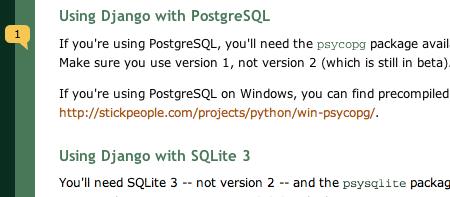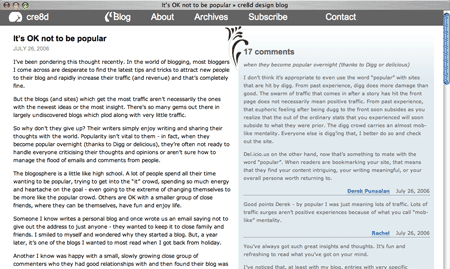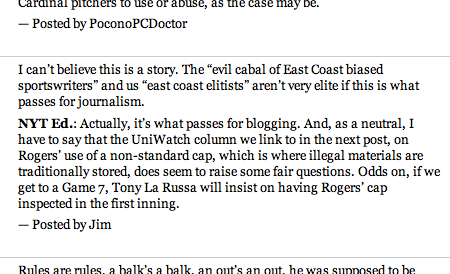Django Book: Comment on text blocks


The Django Book offers an inline commenting system where you can offer comments on a specific block of text. Top screenshot shows normal view, bottom one shows what happens when you click on the “1” comment icon. More details at jackslocum.com. [tx Collin]
Cre8d: Equal billing for comments

Comments are at the top of the page at cre8d — post top left, comments top right — so visitors can catch up on thread action without scrolling.
Bats Blog: Reply on the spot

At The NY Times Baseball blog, the editor responds to commenters at the spot of the original comment instead of later in the thread.

Hollow
on 07 Nov 06I don’t like the Cre8d example. The comments are competing with the article for readers attention. With the background highlighting and curious piece of flair, they’re probably winning.
The NY Times example is nice, if you get there after the fact, but scanning the comments you’ve already read, looking for new comments must be a drag, as there’s no clear starting point for where the comments will pick up. I think that the same criticism can be made of most nested comment systems (ie. digg) which don’t encourage conversation. Then again there’s a similar set up on Newsvine, but there’s something in the soup there that fosters conversation better than other implementations.
Daniel
on 07 Nov 06That Django comment system is brilliant, though I wish you could comment on a larger section of text rather than little chunks. I suppose it’d be difficult to show which section of text the comments referred to, and you could end up with a larger tangle of “thought bubbles” though…
Collin Miller
on 07 Nov 06Details of comment system used in Django book.
It’s a pretty slick system. Not sure if this is exactly what the Django folks used. But this guy blogged it first :D
Greg
on 07 Nov 06It’s nice to see Django finally getting the attention it deserves.
James Bennett
on 07 Nov 06Colin, it is an adaptation of Jack Slocum’s comment system, as noted on the comments help page. Jack rocks :)
Zach
on 07 Nov 06The Django comments system was created by Mr. Jack Slocum (YUI Guru extraordinaire). The imported it into their system (quite beautifully)
Props++
Collin Miller
on 07 Nov 06James,
Fantastic, Just wanted to make sure Jack got a nod from this page. Seems to have worked out.
He’s one of my personal JavaScript heroes.
Raineri Bello
on 07 Nov 06Nice to see Django in this blog. I personally prefer it to any other platform! Love the comment system, can’t wait to get my hands on the finished book.
Dan Boland
on 07 Nov 06I noticed the Django book commenting system a couple of days ago. I think, for this application, it’s absolutely brilliant.
Ryan
on 07 Nov 06Personally, I like the Django commenting system and the cr8d view of the comments. I think both have benefits over the scrolling that takes place on most sites (no offense, mine is the same way).
And I’m aware this isn’t a post promoting Django, but I’d like to check it out. I know Rails has entirely different goals, which demotes the comparisons, but people still compare. Which drives my interests in Django even further, as I’m currently (and completely) amazed at what Rails can do.
Andy Kant
on 07 Nov 06The Django comments system is undeniably slick…but most of the time when I’m looking at documentation I am just doing a CTRL-F and typing in a word or two to get a relevant result. This works with the all comments tab but I would prefer to have the option of a larger block at the bottom instead. Either way it works, kudos on the Django comments interface.
Jeff Croft
on 07 Nov 06I personally think the Django Book’s implementation of the Slocum comment system is brilliant for the needs of this application. More than anything, comments on the Django Book are feedback to the authors, so they can make updates to the text before the book goes to print. It works beautifully for that. What is doesn’t do, though, is facilitate an ongoing discussion of the overall book or chapter. That’s fine, because it doesn’t need to in this context.
But, I sure hope we don’t start seeing this style of commenting on things like blog posts and news stories—I think it’d be totally inappropriate there.
Julian
on 07 Nov 06I think the Django comment approach is great for specific sites, but it might not work with non-tech people, e.g. when implemented on a site with wider audience. I just can’t imagine my dad or so to discover the comments in reasonable time.
sMoRTy71
on 07 Nov 06The Django thing is novel; however, it is not very useful. Look at how much work you have to do to see all of the comments. Clicking and clicking and clicking to open all of the little quote icons. And to Daniel’s point above, how do you comment on the article as a whole?
How is this any more useful than just copying the piece of text you want to comment on and adding that to the top of your comment?
When I want to read comments, I prefer to see them as a single scrolling page (like this one).
Just my take.
smorty71
on 07 Nov 06Should have read Jeff Croft’s comment before I ran my mouth.
I think it is good as a mechanism to give feedback on a manuscript. Not so good for an ongoing discussion.
Artas Bartas
on 07 Nov 06OK. it’s official now. You have one more addicted reader in Lithuania. I don’t think today’s entry has set my heart racing, but boy was i looking forward to reading it?
Philip Gachev
on 07 Nov 06I’m glad to see people beginning to realize the importance of facilitating online public discussion.
But no project comes close to Xanadu, the original hypertext project, http://Xanadu.com.au . Its founder, Ted Nelson, coined the term “hypermedia” and others. Everything in Xanadu has transclusion ( http://en.wikipedia.org/wiki/transclusion ), named fine-grained bidirectional links, transpointing windows, parallel histories. You could comment about any part of content, or a bunch of links, and the comment becomes content. Your comment is automatically visible from the content it refers to and vice versa. Critical discussion and scholarly work would be so much easier!
It would work the same way on your local computer. Commands would link the content, and work anywhere in the content. They would replace applications, which currently constrain what you can do with content because they do not communicate nearly well enough. Software would be much smaller, because much less functionality would be duplicated. It would be much easier to use because the commands would work with any content and with the same user interface. Content would never be lost and links would never be broken (unlike WWW links).
It is very sad that Nelson’s design was not implemented, and instead the “web” is everywhere. We have some partial implementations: ZigZag (FenFire), DeepLit, and others, http://xanadu.com.au/projects.html
Henrik Lied
on 08 Nov 06The system is great for its purpose, no doubt about it. I would really like to see a similar system incorporated at the W3C, more specifically in the Call for Comments section. That’d be lovely.
Tom Armitage
on 08 Nov 06So: in many ways, the Django Book “comments” are only comments in that they’re comments to the editor.
Really, they’re scrawling in the margin of the book, marking up galley proofs. So they’re not comments at all – they’re annotations. When you call them that, the purpose of them – and the unsuitability of them for discussion-type comments – is made more obvious, whilst not diluting the beautiful implementation.
rhubarb
on 09 Nov 06Interesting. How about looking at the different ways sites let you enter commments (captcha, email requirements, preview etc)
Something that was pleasantly new to me recently was the experience of adding a comment on Cringely’s The Pulpit site (now blog) and seeing a preview of the comment below as I typed. This encouraged me to use markup for emphasis. I usually avoid this ecause I can’t be bothered looking up the instructions for textile, or html markup limitations, and I definitely can’t be bothered previewing my comment. With Cringely’s system I could type in html and just backspace over it if it didnt have the effect I wanted.
Mark Coates
on 10 Nov 06Interesting comments, all. This post was especially striking because of a new project we are working on. Serendipity be damned, I pulled up SVN and here was a post on comment formats. We’ll definitely implement/emulate the best of the breed here…
What are features you’d like to see in comments to encourage more discussion - almost forum-like discussion - with comments? Is a quoting feature important (the post or comments)? Emoticons? Markup? Live preview? Please share!
This discussion is closed.